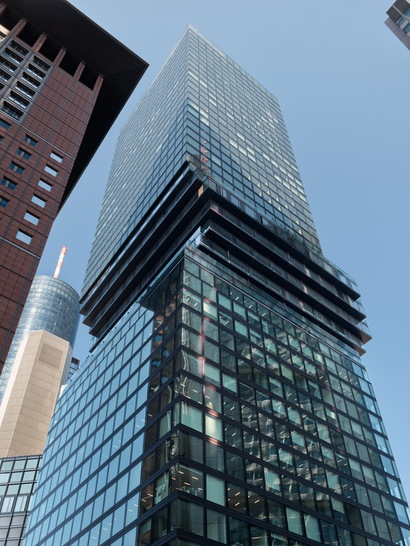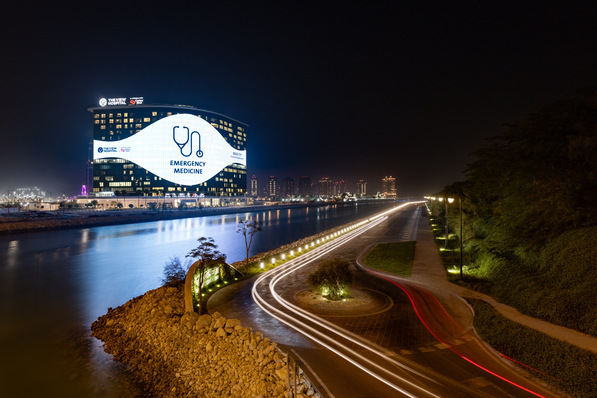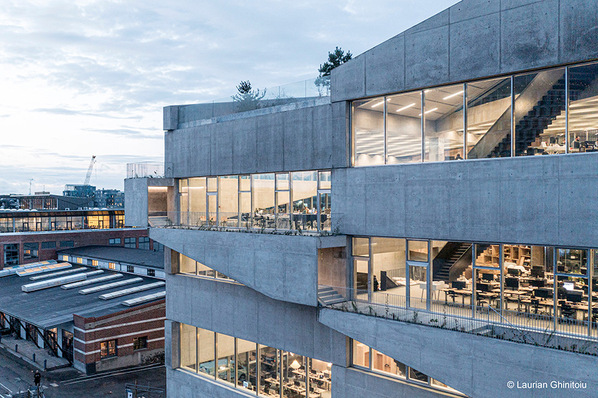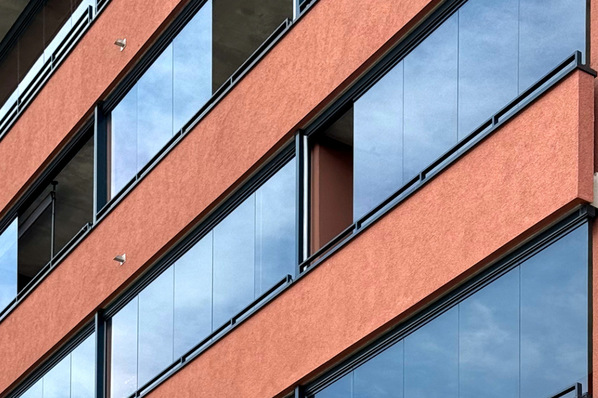Frankfurters describe the curvature in the silhouette of the new high-rise as a "perky hip-swing". Several levels shifted horizontally from the main axis at half height are what make up the striking cubature of the Omniturm. Designed by the Danish architect Bjarke Ingels, the architectural accent is based on the special mix of uses of the high-rise building: the "hip curve" curving out of the facade characterises the living area from the 15th to the 22nd floor, which visually stands out from the linear stacked floors with offices and public uses.
The Omniturm is the first high-rise building in Germany to combine working, living and public areas in its spatial programme. The 45 floors accommodate offices on 44,000 square metres, rental apartments on 8,200 square metres and restaurants and shops on a further 1,700 square metres. The name of the tower is derived from the Latin "omnia" - "everything" - and expresses this.
The shifting of the axes of the residential floors also has a positive effect on the floor plans: This is how the offset balconies of the apartments were created. From a static point of view, however, the "hip-swing" was a challenge - which the planners solved with elegantly inclined supports. Their high-strength steel reinforcement connected to the building core ensures maximum stability.

Saint-Gobain
Sun protection, daylight and filigree corners
A surprising amount of daylight enters the interior of the high-rise through the 15,000 square metres of solar control glass. The Cool-Lite Xtreme 70/33 from Saint-Gobain used for all office floors is a triple solar control glass with an excellent selectivity of 2.12. With its light transmission of 66-70% (depending on the glass structure) it brings plenty of natural light into the building and protects the users from too much solar heat with its g-value of 0.32-0.33 (also depending on the glass structure) and its Ug-value of 1.0 W/m²K.
Speaking of buildings with a twist:
Give this building an Oscar!
In contrast to expectations, the approximately 3,000 x 3,800 millimetre LSG panes are not made of partially tempered glass (TVG) or toughened safety glass (ESG), although this is usually necessary with large-format glass to protect against thermal breakage. The detailed thermal stress analyses carried out by the structural engineers showed that appropriate edge grinding sufficiently increases the load-bearing capacity of the edges and thus also that of the entire pane.
For the corners of the building, the architect had wanted a continuous and filigree appearance. For this reason, profiles were dispensed with there and all-glass corners were chosen. To ensure that these are statically effective, they were designed as stepped insulating glass. A silicone serves as the edge composite material, which also blacks the steps. Since the corner solution of the Omniturm is not subject to the requirements of the technical building regulations introduced, approval in individual cases and external monitoring were required. The IFT Rosenheim was responsible for monitoring the production.
From glass production to prefabrication of the element facade
The production of the impressive quantity of 15,000 square metres of glass was distributed over three Saint-Gobain plants. Each plant took on a special area of responsibility: The Saxon Glassolutions Objekt-Center in Radeburg, for example, concentrated on the overall management of the project in addition to the glass production of the smaller elements. The Glassolutions Austria company Eckelt Glas mainly produced the corner elements and the glasses with a high serial character were manufactured in cooperation with the Saint-Gobain factory Pietta Glass.
See also this article: Frankfurt also has other extraordinary towers:
From each of the three different locations, the panes were delivered directly to the Dobler metal construction company in Deggendorf, Lower Bavaria, which prefabricated the element facade at the plant. Storey-high individual elements, already containing all the necessary components, were finally delivered from there to the Frankfurt construction site and installed directly into the facade.













